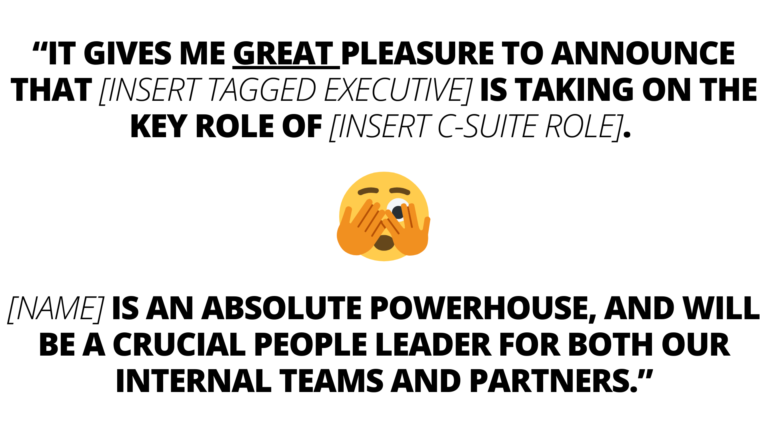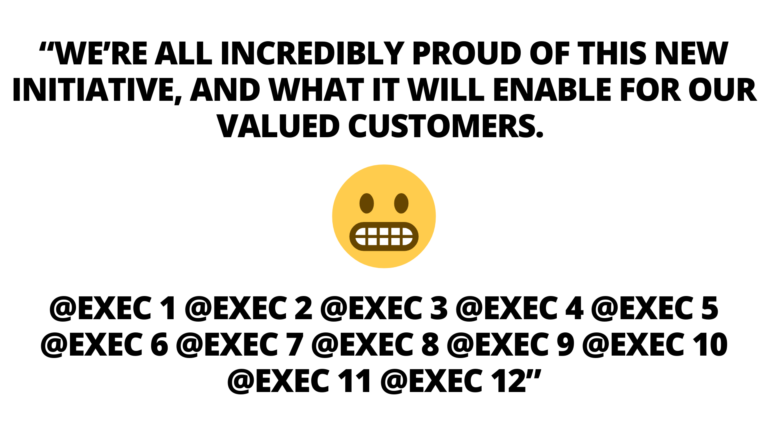
Ever had a major announcement you wanted to make on LinkedIn? Something so important you needed to squeeze every last drop of value out of it?
An executive appointment, a major partnership, financial results, or the launch of a new business or product line?
The sort of thing that could greatly influence your ability to generate sales; attract talent, customers, investors or partners; or give you a competitive edge when you most need it?
If this was you recently – or you have a major opportunity on the horizon – today’s newsletter is all about avoiding some common ‘LinkedIn announcement’ mistakes, and setting you (and your message) up for success.
Reviewing and actioning these steps could well be the difference between a message that sinks vs. one that swims beautifully on the public social web.
With that in mind, here are the five most common ‘major announcement’ mistakes I see from leaders on LinkedIn, and what you can do to avoid them.
Let’s dive in.

MISTAKE #1. Whoops - they don’t use LinkedIn…

The scenario:
An executive colleague is moving into a new role or joining from another organisation. It’s a big deal. As an active leader on LinkedIn, you want to herald their appointment and let the world know they’ve joined or stepped up as a way to drive market interest.
But – their LinkedIn profile is full of dust and cobwebs… They don’t see the post, nor do they reply.
You’d be surprised how common this is – one of Australia’s largest organisations found themselves in this scenario just last week.
Best practice approach:
Tagging your fellow leader in this scenario actually creates brand and reputational risk. Not only are you inadvertently highlighting the other leader is MIA, you’re channelling your own network and credibility to a dead end. That’s a poor user journey.
Before any major announcement, this is what I advise:
1) ensure the dormant leader understands why LinkedIn is being used and it’s value to build critical business relationships at scale;
2) update and optimise their profile to reflect their current role; and
3) develop a comms plan to ensure the leader is clear on how best to respond in an authentic way to give the post its intended reach.
MISTAKE #2. Whoops - I don’t use LinkedIn?!
The scenario: You’re moving into a new executive role and need to let people know. Your comms team handles the website profile and media announcement, but you’re hamstrung on LinkedIn – you either don’t have a profile, or you have one that (as above) has cobwebs…
You’re unable to control the message going out to your network and lose access to the immense benefits that come from making the announcement on LinkedIn. Again, this happened to a major Aussie brand just last week.
Best practice approach: As above, you can’t simply ask a more active leader to make the post and tag you – that creates problems.
Instead, take the opportunity to:
1) learn why and how LinkedIn can add value to build critical business relationships at scale;
2) update and optimise your profile to reflect your current role; and
3) work with your comms team to develop a posting calendar and engagement plan to capitalise on the opportunity.
Posts made by individuals travel much further – and with greater interest – than company posts.
MISTAKE #3. Let's just tag everyone.

The scenario:
It’s the big day of the announcement. Everyone knows, has been briefed, and is ready to flood LinkedIn’s feeds with a wave of brand positivity. The profiles of the 12 most relevant leaders and team members have been shared around so they can all be tagged. But, by tagging them, two problems emerge:
1) all 12 must now engage with every post, or they will inadvertently reduce reach on every post…; and
2) as all 12 engage, they inadvertently create a ‘ring fence’ around the content, so only people in your organisation see the announcement.
Best practice approach:
As part of your planning process, it’s vital you consider the key people who need to be acknowledged or who need to be aware of the announcement.
But, for LinkedIn, this means the audience receiving the message, not delivering it. LinkedIn is all about relationships, not broadcast – common mistake #4 (below) makes this clear.
Here’s what I recommend:
1) develop a stakeholder map detailing those key recipients, even ranking them based on their importance to your organisation;
2) then identify who from your team is most likely to reach and influence them;
3) be selective – it won’t be everyone (and is often not the most senior person); and
4) then execute with a cadence that makes sense to your target audience – not everyone in one big burst at 11.15am on Thursday.
MISTAKE #4. I don't have time to engage.
The scenario:
All the time and effort has gone into crafting the perfect message and visual asset for LinkedIn. It’s been weeks in the making.
Sure, you’ve been quiet on LinkedIn while all this behind-the-scenes planning has gone on, but the big reveal will be worth it. Your collective hearts beat that little bit faster as fingers hover over mouse buttons to push that precious message public.
*Click*
The much-anticipated result is, sadly, far less fanfare than you were expecting. What went wrong?
Best practice approach:
LinkedIn is all about relationships, not broadcast. Failing to engage means failing to get cut through. A best practice approach means leveraging that stakeholder map above.
When working in with leaders, here’s what I advise:
1) design and/or leverage the above stakeholder map;
2) intentionally engage with key people you want to see your message weeks ahead of time – including right up to the day itself;
3) post your key announcement publicly; and
4) send your post to very select individuals via private message.
Your announcement may be the biggest thing in your world, but its ability to reach the right people depends on your ability to engage with them ahead of time. The ‘big reveal’ doesn’t cut it on LinkedIn.
MISTAKE #5. LinkedIn is our last thought.
The scenario:
You and your comms team have spent considerable time and effort getting all your messages ready for key channels and audiences. The focus had been a media exclusive which, you hope, will generate the buzz you’re after.
The day arrives.
You read the paper – it’s a pretty good summary, but not all the key messages you wanted. You wait with anticipation for what comes next.
A week later, you realise that – in the excitement – no one remembered to get it out on LinkedIn. You post a link to the original article. But the moment’s lost, as is the impact and opportunity.
Best practice approach:
LinkedIn (and social media more broadly, to some extent) is unique and incredibly valuable among other comms channels. Why? Because it provides an owned environment, filled with trusted contacts, that you can use strategically to prepare for, announce, and then capitalise on any major announcement.
We both know how the system works – mainstream media don’t want to hear your lead up story weeks in advance. But you can get people excited, intrigued, even reaching out to you ahead of time, via your LinkedIn efforts.
Rethink LinkedIn’s strategic role for comms. It’s your most powerful tool to reach and influence very specific or very large audiences – and you’re in control. Use all your small stories in the lead up to the big one – they’re the reason the big ones work.
If you need your messages to cut through – if you need the benefits that come from direct access to talent, customers, partners, investors and more – LinkedIn is an enormous opportunity.
If you want to make sure your next major announcement meets your objectives, drop me a note. I’m always happy to share industry examples and frameworks that will be difference between a sink or swim online.
Take care,
Roge

Want more just like this delivered straight to your inbox? Join hundreds from around the world receiving Roger Christie’s latest digital reputation advice, trends and the best practice examples of the leaders getting it right online. We’d love to have you part of this growing community.